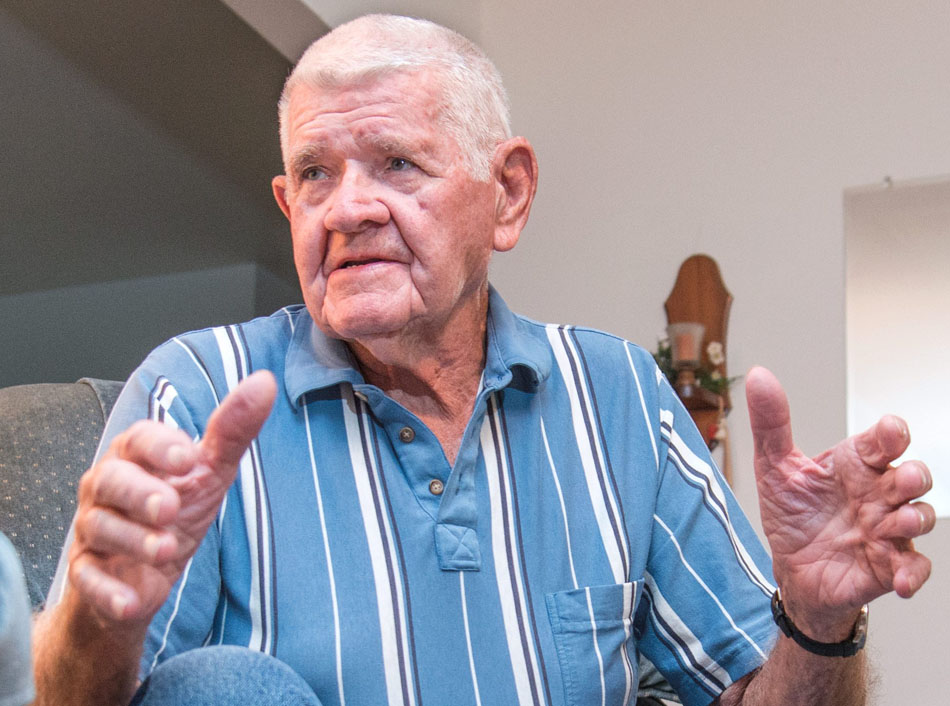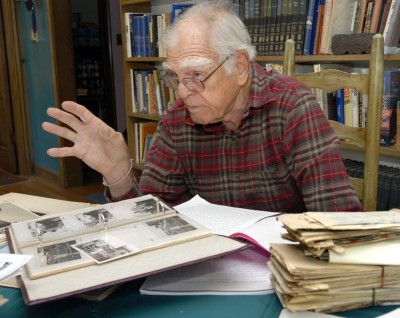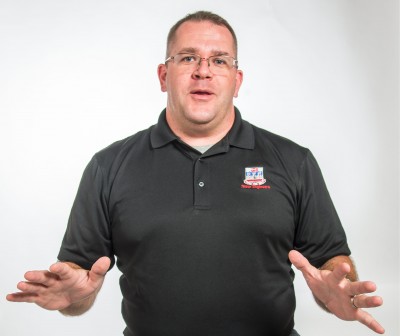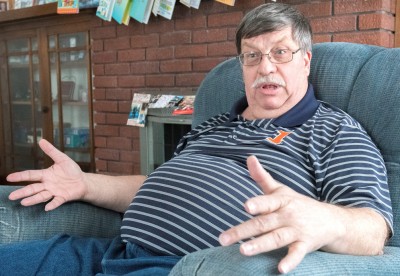Harold Thomas
By Paul Wood

Photo By Robin Scholz/The News-Gazette
PHILO — Harold Thomas saw a kamikaze plane up close as it rammed into the USS Idaho, and survived with only some hearing loss.
He served in the Marines in the South Pacific, including Okinawa and Iwo Jima.
A farm boy who was too busy with chores to play sports at Tuscola High School, Thomas, now 90, made it into the Marines almost by chance.
He had been drafted into the Army right out of high school and was on his way to serve with a couple of friends when they ran into a Marine recruiter.
The recruiter said that if they joined the Marines, the friends could stay together.
“We were green as grass,” Thomas says now. “He had a quota to fill, and we never did see each other again.”
After boot camp, once again he was caught in a quota: sea duty. Marines were asked to volunteer to serve on ships.
“We learned never to volunteer,” but he was volunteered, called out to take on the duty.
The South Pacific was hot, steamy hot. When it came time to sleep, Thomas learned to take a blanket and go up high above the deck to a gun mount, where it was cooler and there was a breeze.
“You didn’t want to be a sleepwalker then,” he says.
The sailors and Marines listened to the swing music of Tokyo Rose, the Japanese propagandist, and tried to tune out her taunts about their girls back home.
At Iwo Jima in February 1945, a pontoon plane from his ship searched for targets for the big guns. Thomas manned a 20-millimeter anti-aircraft gun, called “the kamikaze killer,” earning a Bronze Star for several actions.
By April, the time the Marines neared Japan by attacking Okinawa in the largest amphibious assault in the Pacific conflict, the enemy was desperate and depending heavily on kamikaze suicide bombers.
“They were throwing everything they had at us,” Thomas says. “The kamikazes came in at every sunset.”
The planes came in out of the sun to work with its glare and flew low enough to prevent radar from detecting them, Thomas says.
“They were really low in the water, and the 20-millimeters couldn’t swing around to shoot them. But the 40-millimeter guns above us could,” he says.
One sunset, five kamikaze planes came at the Idaho.
“We knocked three out. One of the 40s got the fourth, and it disintegrated,” Thomas says.
But the fifth kamikaze plane followed right behind the fourth as they approached the battleship.
“Our guns couldn’t train on it,” he says. “The 40s were pumping lead as fast as they could.”
The plane and a 500-pound bomb hit the ship’s “blister,” one of the anti-torpedo bulges on each side of the Idaho. Thomas says it was like a tidal wave hit the ship.
“I saw it coming in, and I thought it was all over,” he says.
Though he suffered a concussion and hearing damage, he realized: “Hell, I believe I’m alive.”
Other guys “began to stir,” and Thomas went back to his duties, not seeking medical attention.
The Idaho had temporary repairs, then sailed to Guam.
“That was the biggest dry dock I ever saw,” he recalls.
The ship was then on its way to Tokyo Bay.
The Marines had .45 pistols on board the ship and had to re-train on rifles for the intended invasion of Japan.
But that never happened; the war had ended.
After his service, he married the girl back home, Betty, and they had five children.
He worked as a carpenter, built his own house and still is on the job at 90, taking care of a nearby cemetery.
Do you know a veteran who could share a story about military service? Contact staff writer Paul Wood at pwood@news-gazette.com.
Read more stories from local veterans:
 Ralph Langenheim
URBANA — A D-Day veteran calls his own service in World War II “small potatoes.” Fresh out of geological engineering sch …
Ralph Langenheim
URBANA — A D-Day veteran calls his own service in World War II “small potatoes.” Fresh out of geological engineering sch …
 Timothy Joseph Newman
FISHER — In his 18 years as an officer — so far — Timothy Joseph Newman has earned two Bronze Stars, one while serving a …
Timothy Joseph Newman
FISHER — In his 18 years as an officer — so far — Timothy Joseph Newman has earned two Bronze Stars, one while serving a …
 Steven Morenz
CHAMPAIGN — Steven Morenz, a top-secret coder during the Vietnam War, just came back from a Land of Lincoln Honor Flight …
Steven Morenz
CHAMPAIGN — Steven Morenz, a top-secret coder during the Vietnam War, just came back from a Land of Lincoln Honor Flight …